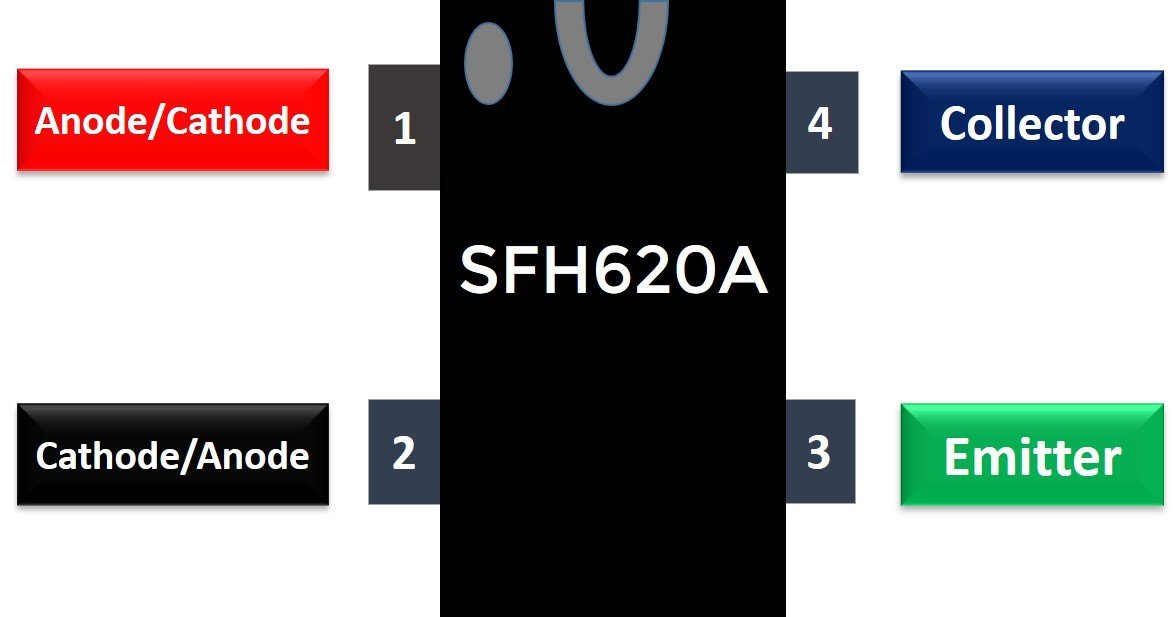Optocouplers or Optoisolators are mainly used for the electrical isolation between two circuits just using the light. SFH620A is an Optocoupler that has two parts i.e., two GaAs Infrared emitting diodes and a phototransistor, which functions by sensing the infrared light. It offers a high current transfer ratio, low coupling capacitance, and high isolation voltage all in a small, insulated box. It provides 5300 VRMS for safe electric signal transmission and electrical isolation.
SFH620A Optocoupler Introduction
SFH620A comes in DIP-4 and SMD packages. It finds its applications in different circuits for removing noise, isolating high voltage circuits from low voltage circuits, switching, and controlling higher AC voltages.
The tutorial deals with pin configuration, features, specifications, example circuits, and applications.

SFH620A Pinout
The following diagram shows the pinout of the SFH620A Optocoupler:

The plastic box has two sections i.e LEDS which takes in the input and generates light proportional to it and a silicon planar phototransistor that senses this light, turns on, and starts current conduction just like a typical transistor.
Pin Configuration
Let us discuss the pinout of the SFH620A Optocoupler. The pin configuration detail in tabular is mentioned below:
| Pin Number | Pin Name | Function |
|---|---|---|
| 1 | Anode/Cathode | Light Emitting Diode Anode/Cathode pin |
| 2 | Cathode/Anode | Light Emitting Diode Anode/Cathode pin |
| 3 | Emitter | Phototransistor Emitter pin |
| 4 | Collector | Phototransistor Collector pin |
Features and Specifications
- Collector Emitter Voltage: 70 Volts
- Emitter Collector Voltage : 7 Volts
- DC Forward Current: ± 60 mA
- Forward Voltage: 1.25 Volts
- Collector Current: 50 mA
- Total Power Dissipation: 150 mWatts
- Creepage distance: > 7mm
- Clearance distance: > 7mm
Useful Features
SFH620A Optocoupler comes has some useful features which are listed under:
- High current transfer ratios – at 5 mA: 50 to 600 % – at 1.0 mA: 45 % typical (> 13)
- Low CTR degradation but good CTR linearity depending on forwarding current
- 5300 VRMS of isolation test voltage
- High collector-emitter voltage of 70V
- It comes with low saturation voltage but is capable of fast switching
- The optocoupler is end stackable with 0.100″ (2.54 mm) lead spacing
- It has two Infrared Emitting diodes connected in parallel and reverses direction
- It is also available in SMD package.
SFH620A Optocoupler Example Circuits
The example circuit of SFH620A Optocoupler is shown below to describe its use.
Switching Circuit
The schematic given below is a switching circuit using SFH620A Optocoupler.

The input is applied to the first part of the optocoupler which is the LEDs. A resistor is connected in series with the LEDs to limit the current through the LEDs. The current in return controls the intensity of the infrared light emitted through them which is responsible for phototransistor gain. The lower the value of limiting resistance, the higher will be the phototransistor gain. The load is placed at the phototransistor part. Here comes the switching part.
If infrared radiations are detected by the phototransistor enough to turn it, it will start conducting current from emitter to collector. But as a pull-up resistor is connected with the phototransistor and output state will be low i.e. 5 volts will be stepped down to 0 and let say an LED is connected as a load, it will not glow. If no radiations are sensed by the phototransistor, it conducts no current, and the output state will be high. And let us say if there is an LED connected at the output state it will glow.
SFH620A Alternative Options
- PC817
- LTV817
Applications
- AC/DC Switching Circuits
- Signal Isolator Circuits
- Analog Current Detection
- Power Control
2D Diagram
The following figure shows the 2d model of SFH620A Optocoupler IC. It shows us the physical dimensions in millimeters required when a PCB card is designed.

DATASHEET
The datasheet link is given below to see further details and specifications of the SFH620A Optocoupler.
Related Articles:
- EL357 Optocoupler
- MOC3041 Zero Crossing Optocoupler
- 6N137 High Speed Optocoupler
- PC817 Optocoupler
- How to use isolated MOSFET driver TLP250
- 6N135 High Speed Optocoupler
- 4N25 Phototransistor Optocoupler
- MOC3021 Triac drive Optoisolator
- adjustable firing angle control of thyristor using arduino
- AC load interfacing with pic microcontroller
